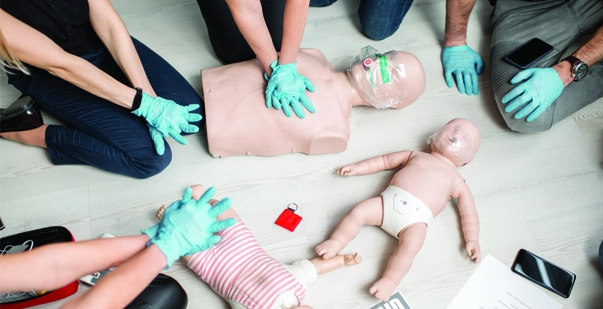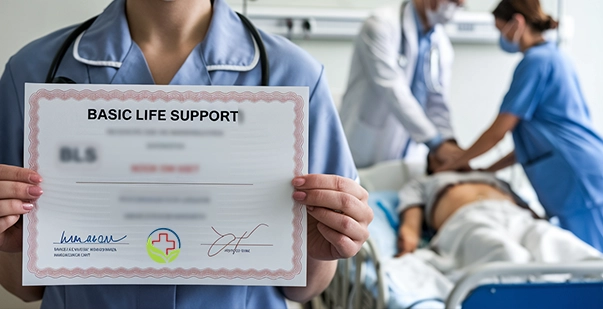Cardiopulmonary resuscitation (CPR) is a lifesaving technique that can help save someone’s life during a cardiac arrest. CPR involves chest compressions and rescue breaths that help maintain blood flow and oxygenation to the body’s vital organs until medical help arrives. Many people wonder if learning CPR is worth the effort and if it makes a real difference and proves to be a life saving skill. In this article, we will explore the importance of CPR and the impact it can have on saving lives.
Choose to make a difference and give back to humanity by registering and signing up with the American HealthCare Academy today. If you are wondering how long does CPR certification last? It stays valid for two years and can be renewed when it’s near expiry. Contact us today!
Why should I learn CPR?
Learning CPR (Cardiopulmonary Resuscitation) is essential because it can save lives in emergency situations. Here are a few reasons why you take CPR training and CPR certification:
- Save a life: CPR can keep a person alive until emergency medical services arrive. For example, if someone suffers a heart attack or drowns, CPR can help maintain blood flow and oxygen to vital organs, increasing the chances of survival.
- Immediate response: CPR can be performed immediately after an incident, and it can buy time until medical professionals can take over.
- Be prepared: Emergencies can happen anytime and anywhere, and learning CPR can make you prepared to handle them. Knowing how to perform CPR can give you confidence and peace of mind in emergency situations.
- Assist in a workplace emergency: In some jobs, such as lifeguard, nurse, or security guard, knowing CPR is required. Being able to perform CPR can also make you a valuable asset in the workplace.
- Empowerment: Learning CPR gives you the ability to make a difference in someone’s life. You could save a loved one or even a stranger’s life with your skills.
Overall, learning CPR is a valuable skill that can benefit you and those around you. It’s an investment in yourself and others that can make a significant difference in an emergency.
Why is online CPR training the need of the hour?
What is the best method to learn CPR? Online CPR training is a convenient and accessible way to learn CPR skills. Here are a few reasons why online CPR training is needed:
- Convenience: Online CPR training can be completed at any time and from anywhere, as long as there is an internet connection. This makes it easy for people with busy schedules or limited access to traditional CPR classes to learn CPR.
- Cost-effective: Online CPR training is often less expensive than in-person classes. This makes it accessible to more people who may not have the budget for traditional CPR training.
- Flexibility: Online CPR training can be completed at the learner’s own pace, allowing them to spend more time on challenging concepts and skip over material they already know.
- Interactive learning: Online CPR training often includes interactive simulations, videos, and quizzes that engage learners and help them retain information better.
- Pandemic response: During the COVID-19 pandemic, online CPR training has become even more important as traditional in-person classes have been limited or canceled. Online CPR training provides a safe alternative to in-person training and allows learners to maintain their CPR certification.
Overall, online CPR training is a convenient, cost-effective, and flexible way to learn CPR skills. It provides an excellent opportunity for individuals to gain the knowledge and confidence they need to perform CPR in an emergency. Tired of searching for for “good CPR classes near me”? Register with us for free CPR classes online.
What are the three important steps of CPR?
The three important steps of CPR are:
- Call for help: The first step in CPR is to call for emergency medical services (EMS) immediately. Time is critical during a cardiac arrest or other medical emergency, and the sooner EMS can arrive, the better.
- Perform chest compressions: The next step is to begin chest compressions. To do this, place the heel of one hand on the center of the person’s chest, with the other hand on top. Then, press down firmly and quickly at a rate of 100-120 compressions per minute, allowing the chest to recoil fully between compressions.
- Give rescue breaths: The third step is to give rescue breaths. Tilt the person’s head back with one hand, pinch their nose closed with the other, and give two breaths into their mouth. Each breath should last about one second and make the person’s chest rise.
These three steps of CPR, when done correctly and in the proper order, can help maintain blood flow and oxygen to vital organs, increasing the person’s chances of survival until EMS arrives. It’s important to note that CPR training can teach you the proper techniques and guidelines for performing CPR effectively.
Conclusion
Learning CPR can make a significant difference in saving someone’s life during a cardiac arrest. By taking a CPR course, individuals can gain the skills and confidence to respond quickly and effectively in an emergency. CPR can help maintain blood flow and oxygenation to vital organs, which can be critical in increasing the chances of survival until emergency medical services arrive. Therefore, it is crucial to learn CPR and take a course to help make a difference in an emergency.










